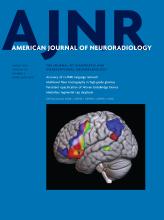Research ArticleHead and Neck Imaging
Increased Labyrinthine T1 Postgadolinium Signal Intensity Is Associated with the Degree of Ipsilateral Sensorineural Hearing Loss in Patients with Sporadic Vestibular Schwannoma
J.P. Welby, J.C. Benson, C.M. Lohse, M.L. Carlson and J.I. Lane
American Journal of Neuroradiology March 2023, 44 (3) 317-322; DOI: https://doi.org/10.3174/ajnr.A7800
J.P. Welby
aFrom the Departments of Radiology (J.P.W., J.C.B., J.I.L.)
J.C. Benson
aFrom the Departments of Radiology (J.P.W., J.C.B., J.I.L.)
C.M. Lohse
bQuantitative Health Sciences (C.M.L.)
M.L. Carlson
cOtorhinolaryngology (M.L.C.), Mayo Clinic, Rochester, Minnesota
J.I. Lane
aFrom the Departments of Radiology (J.P.W., J.C.B., J.I.L.)

Submit a Response to This Article
Jump to comment:
No eLetters have been published for this article.
In this issue
American Journal of Neuroradiology
Vol. 44, Issue 3
1 Mar 2023
Advertisement
J.P. Welby, J.C. Benson, C.M. Lohse, M.L. Carlson, J.I. Lane
Increased Labyrinthine T1 Postgadolinium Signal Intensity Is Associated with the Degree of Ipsilateral Sensorineural Hearing Loss in Patients with Sporadic Vestibular Schwannoma
American Journal of Neuroradiology Mar 2023, 44 (3) 317-322; DOI: 10.3174/ajnr.A7800
Jump to section
Related Articles
- No related articles found.
Cited By...
- Inner Ear Signal Abnormalities of Adjacent Intracranial Lipochoristoma
- Vestibular Schwannoma-Related Increased Labyrinthine Postgadolinium 3D-FLAIR Signal Intensity and Association with Hearing Impairment
- Peritumoral Signal on Postcontrast FLAIR Images: Description and Proposed Biomechanism in Vestibular Schwannomas
This article has not yet been cited by articles in journals that are participating in Crossref Cited-by Linking.
More in this TOC Section
Similar Articles
Advertisement











